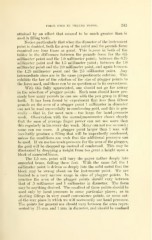Page 519 - My FlipBook
P. 519
FORCE USED IN FUELING TEETH. 243 ;
attained by an effort that seemed to be much greater than is
used in filling teeth.
Notice particularly that when the diameter of the instrument
point is doubled, both the area of the point and the pounds force
required are four times as great. This is. seen in both of the
tables in the difference between the pounds force for the 0.5
millimeter point and the 1.0 millimeter point ; between the 0.75
millimeter point and the 1.5 millimeter point; between the 1.0
millimeter point and the 2.0 millimeter point, and again between
the 1.25 millimeter point and the 2.5 millimeter point. Any
intermediate sizes are in the same proportionate relation. This
exhibits the law of the relation of the size of plugger points to
the force used, and there can be no question as to its correctness.
With this fully appreciated, one should not go far astray
in the selection of plugger points. Each man should know pre-
cisely how many pounds he can use with the pen grasp in filling
teeth. It has been found by experiment that less than fifteen
pounds on the area of a ])lugger point 1 millimeter in diameter
can not be used successfully in condensing gold, and this is gen-
erally — that is, for most men — too large for hand-pressure
work. Observation with the manudynamometer shows clearly
that the man of average finger power can not use more than
this regularly in his every-day work. Many can not use so much
some can use more. A plugger point larger than 1 mm. will
inevitably produce a filling that will be imperfectly condensed,
unless the conditions are such that the additional pressure can
be used. If we use too much pressure for the area of the plugger,
the gold will be chopped up instead of condensed. This may be
illustrated by dropping a weight from too great a height upon a
block of annealed brass.
The 1.5 mm. point will bury the paper rather deeply into
annealed brass, falling three feet. With the same fall the 1
millimeter point is driven so deeply into the solid metal that the
block may be swnng about on the instrument point. We are
limited to a very narrow range in sizes of plugger points. In
practice the area of the plugger points should vary between
that of .5 millimeter and 1 millimeter in diameter. The form
may be anything desired. The smallest of these points should be
used only by hand pressure in some particular places ; as in
starting fillings in veiy small convenience points, or some out-
of-the-way place in which we will necessarily use hand pressure.
The points for general use shovild vary between the area repre-
sented by .75 mm. and 1 mm. in diameter, and should be confined


